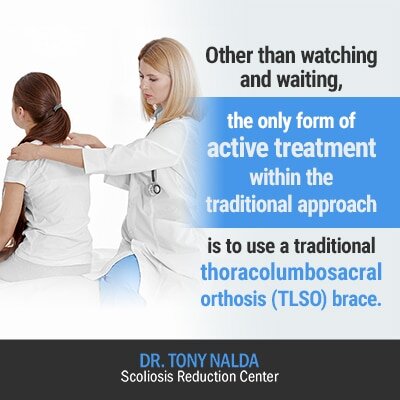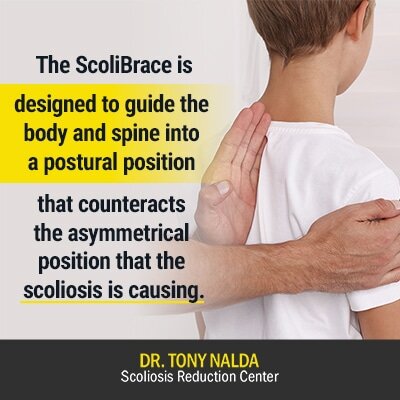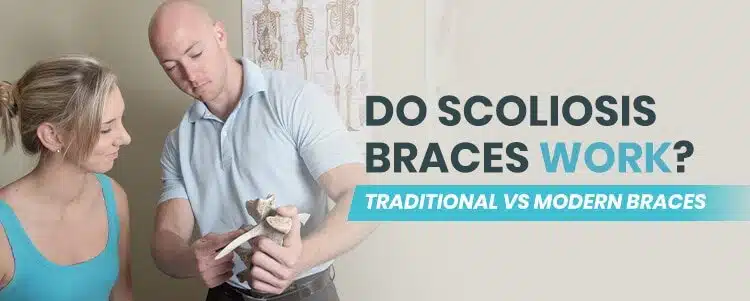Traditional and modern scoliosis braces differ in many ways, but when it comes to treatment efficacy, the big difference is in the end goal. Traditional braces are used to slow/stop progression, while modern braces are used to actually ‘correct’ an abnormal curvature; I favor the latter.
When it comes to treating scoliosis, an integrative approach best addresses the needs of the condition. This is partially because scoliosis differs so much from one patient to the next, and also because as a complex condition, it benefits from the merits of multiple treatment disciplines. Let’s first discuss the two main approaches to scoliosis treatment, and then move on to traditional vs modern braces.
Two Main Scoliosis-Treatment Approaches: Traditional vs. Functional
There are two main treatment approaches to scoliosis: traditional and functional. While the traditional treatment approach has been the dominant choice for many years, the functional approach has been steadily gaining in respect and popularity over the years.
Traditional Treatment Approach
Traditional treatment involves a lot of passive observation until a patient’s abnormal spinal curvature reaches surgical level, usually at 40+ degrees; at that point, spinal-fusion surgery is often recommended as the best course of treatment.

Watching and waiting is a dangerous strategy to employ when it comes to an incurable and progressive condition like scoliosis. When a condition has progressed, which it is bound to do, the patient’s curvature degree has increased, along with the likelihood of developing adverse symptoms and/or potential complications.
Other than watching and waiting, the only form of active treatment within the traditional approach is to use a traditional thoracolumbosacral orthosis (TLSO) brace. Even then, the goal of the brace is not to actually correct the abnormal spinal curvature, but to slow/stop its progression.
Functional Treatment Approach
My functional treatment approach is proactive and involves combining multiple disciplines to design a fully-customized treatment plan.
Here at the Scoliosis Reduction Center®, we combine scoliosis-specific chiropractic adjustments, therapy, rehabilitation, and corrective bracing. We favor the corrective ScoliBrace as it has a lot of benefits in terms of compliance and efficacy.
We don’t watch and wait; we act by starting treatment as close to the time of diagnosis as possible so we don’t waste any valuable treatment time.
There is no harm to reducing a mild or moderate curve, but there is a lot of potential harm to watching while a patient’s curvature progresses unimpeded and then saying, “Well, now the curvature is so severe, we need to do surgery.”
Now that we have looked at the different ideologies behind the two main scoliosis-treatment approaches, let’s take a look at the differences between the types of braces used: traditional TLSO brace vs the modern ScoliBrace.
Traditional TLSO Braces
Thoracolumbosacral orthosis refers to a brace used to address abnormal spinal curvatures of the middle and lower back. The Boston brace is the most commonly-used TLSO brace in the United States for treating scoliosis.
With TLSO braces like the Boston brace, there are strategically-placed pads that apply pressure to the unhealthy spinal curves in the hope that it will slow down/stop growth in those areas.
The Boston brace has a corset-style, is made of plastic, and comes in small, medium, or large; it would need to be worn virtually all the time (18 – 23 hours a day) for 3 to 5 years.
We will revisit the difference of using bracing in adult and adolescent scoliosis treatment, but for now, it’s important to know that adolescent idiopathic scoliosis (AIS) is the condition’s most common form, so bracing is most commonly used for this age group.
When it comes to treating adolescents between the ages of 10 and 18 (most common diagnosis age), you can imagine how important compliance would be.
Boston braces are uncomfortable, bulky, and need to be worn virtually all the time. Does this sound like something an average teenager would want to do?
While it is possible to conceal the Boston brace under some forms of baggy clothing, in general, it is difficult to hide, and with many teenagers, that brace will be removed, placed in a locker, or in the back of a car until the school day, or other outings with friends, are over.
As you can imagine, the brace’s efficacy is based on full-time wear, so if compliance is an issue, its efficacy is greatly reduced.
Remember, the end goal of this type of brace is not to actually correct the abnormal curvature, but to slow its growth.
The Modern ScoliBrace
Here at the Center, as one component of our functional treatment approach, we favor the use of corrective braces such as the ScoliBrace.
ScoliBrace uses a modern 3D approach to bracing, and as scoliosis is a 3-dimensional condition, this better addresses the nature of the deformity.
ScoliBrace uses state-of-the-art scanning technology, X-ray and postural images to get a truly customized fit that is bespoke to the patient’s body type and condition. The ScoliBrace is fitted to the patient by a trained and certified ScoliBrace provider.
To return to the compliance issue associated with the Boston brace, imagine the benefit of a brace that features a more modern design and is fully customized to suit the patient’s body. It is made out of flexible plastic, has multiple color and pattern options, and is barely visible under clothing.

While the aforementioned differences are substantial, the biggest difference is in the end goal. With the ScoliBrace, the ultimate treatment goal is not to slow or stop progression, but to actually over-correct.
The ScoliBrace is designed to guide the body and spine into a postural position that counteracts the asymmetrical position that the scoliosis is causing. When the spine is still growing, such as in children and adolescents, when combined with other forms of treatment, this can help reduce the abnormal curvature and produce a structural change.
This is the most important difference between traditional and modern braces: the goal of traditional braces is to ‘hold’ the spine so the curvature doesn’t progress, while the goal of modern bracing is to actually ‘correct’ the spinal deformity on a structural level.
Treatment by Age: Bracing for Adults vs Bracing for Adolescents
While scoliosis is far more common in children and adolescents, adults can develop the condition too. The two main forms of adult scoliosis are adolescent scoliosis in adults (ASA) and degenerative scoliosis (ADS).
Both in terms of treatment and condition experience, the big difference between scoliosis in adolescents and adults is skeletal maturity.
Adult Scoliosis
Adults have reached skeletal maturity, meaning their spines are no longer growing.
This is important for scoliosis in two main ways. Firstly, adult scoliosis is more likely to be painful because their spines are vulnerable to the compression caused by the abnormal spinal curvature. Secondly, as growth is the big trigger for rapid progression, adults have this trigger removed, so their scoliosis tends to progress at a slower rate than in adolescents.
While approximately 70 percent of adult-scoliosis cases do not need bracing, the remaining 30 percent can benefit from a treatment combination of scoliosis-specific exercise and modern bracing.
For adults with scoliosis, bracing still has a place, but tends to be used more generally for pain management; however, every case is different, and it can still be used in conjunction with other disciplines to work towards a curvature reduction.
Bracing and Adult Scoliosis
In adolescent scoliosis in adults, the condition has been left to progress over the years. Unfortunately, had the condition been diagnosed and treated in adolescence, the patient would be in a lot better shape.
In degenerative scoliosis, this is most common in adults over the age of 40 as natural degenerative changes, such as damage to the intervertebral discs, can lead to the spine slipping out of alignment.
While adolescent scoliosis in adults tends to slow progression, as a patient ages and enters into the 40+ range, progression can increase as the condition is exacerbated by the natural degenerative effects of aging on the spine and its discs.
In patients with degenerative scoliosis, most curvatures measure at less than 30 degrees when they are first diagnosed, but curve sizes can range dramatically.
While a curvature of less than 30 degrees falls into the ‘moderate scoliosis’ classification, if left untreated, progression is generally in the range of 0.5 – 3 degrees a year; cumulatively, that can add up to a huge curvature developing over time.
Bracing has become more commonly used in treatment of adult scoliosis and can be effective when used as one facet of an integrative treatment approach.
Braces used in treating adult scoliosis with the goal of pain relief generally need to be worn for 4 – 6 hours a day; bracing used with the goal of reducing a curve would need to be worn for approximately 20 hours a day.
Fortunately, most cases of adult scoliosis can be treated effectively with a combination of scoliosis-specific chiropractic adjustments, exercise, therapy, and selected bracing.
It is important, however, to remember that bracing on its own is not an effective treatment method for any type of scoliosis.
Adolescent Idiopathic Scoliosis
As the condition’s most common form, AIS makes up 80 percent of known diagnosed cases. The ‘idiopathic’ designation means there is no known single cause for the condition’s development.
The good news is that although we don’t know what causes AIS, we most certainly know how to treat it effectively and manage its progression.
When treating adolescents, monitoring is important as the puberty stage is marked by rapid and unpredictable growth spurts, and growth is the number one trigger for progression.
Fortunately, AIS is not known to be a painful condition as the spine is still growing and is constantly experiencing a lengthening motion that counteracts the progression caused by an unhealthy curvature.
While the lack of pain in AIS is, indeed, fortunate for those living with the condition, in terms of early diagnosis, this poses an extra challenge; conditions that aren’t painful and don’t always produce noticeable symptoms often go undiagnosed, hence the prevalence of ASA cases.
Bracing and Adolescent Idiopathic Scoliosis
As discussed previously, if an adolescent patient was to find themselves on the traditional treatment path, they would likely be told to return periodically for X-rays while their condition was in the mild and moderate stage.
If their condition was found to be progressing, which it inevitably would, they would likely be instructed to wear a Boston brace fulltime for 3 – 5 years in an attempt to slow/stop the curvature’s progression.
If a teenager was to wear a Boston brace full time until they reached skeletal maturity, in theory, that’s when progression slows naturally as its big trigger (growth) has been removed.
But what happens as that patient ages? Even if the Boston brace was viewed as successful by holding off progression long enough to avoid surgery during the teenage years, the brace didn’t actually reduce the curvature, and just held it so it wouldn’t progress.
As that patient ages and faces the natural degenerative effects of aging, that curvature can continue progressing.
If that same patient had walked the functional treatment path with me, their treatment experience and results would likely be very different.
In my functional approach, bracing would have only been one component of active treatment, and if I was to use bracing, I would opt for the modern ScoliBrace, rather than a traditional brace like the Boston.
Based on the patient’s scoliosis X-ray and comprehensive exams and observation, I would have designed a proactive treatment plan that was started immediately.
I would combine scoliosis-specific chiropractic, therapy, rehabilitation, and the corrective ScoliBrace, with the end goal of reducing the curvature on a structural level. We want to ‘correct’ the spine’s unhealthy curvatures and work towards strengthening and stabilizing it naturally, rather than holding it so the condition doesn’t progress.
With a growing spine, corrective bracing can be highly effective when combined with other treatment disciplines. The ScoliBrace addresses the 3-dimensional nature of the condition, unlike the traditional Boston brace.
The Boston brace holds the spine by squeezing it, and this can actually worsen the rotational aspect of scoliosis as it squeezes the body from both sides; the ScoliBrace is superior in design as it pushes the spine into a corrective position, rather than holding it.
Then the additional treatment disciplines, already mentioned, would work to support, stabilize, and strengthen the spine so that it could remain in the corrective position naturally.
The ScoliBrace is versatile, custom designed, and corrective. When used in conjunction with other disciplines, modern corrective bracing for AIS can help achieve a curvature reduction that means never reaching surgical level.
Bracing is not for everyone, and each and every patient will have to discuss their condition with the doctor in charge of administering their treatment to determine if it should be included in their treatment regime.
However, I also caution that although there are many different types of braces on the market to choose from, not all are created equal, and there are still some disadvantages to bracing that should be considered.
Bracing Disadvantages
Wearing a brace can be restrictive and make sports and exercise more of a challenge. It can also be uncomfortable and make compliance a very real issue, particularly for children and adolescents.
Although there is a 75-percent chance that a brace can stop progression to the point that surgery is not needed, that still means that one in every four patients could go through wearing a brace for many years, only to discover they need surgery anyway.
Since a traditional brace doesn’t correct the curvature, but holds it so it doesn’t get worse, the underlying problem is still there: the spinal misalignment coinciding with rotation and the related disc problems that can develop along with it.
Also, just because a brace is successful at stopping progression during the teenage years, doesn’t mean that progression in adulthood won’t occur. As progression continues into adulthood, the spine becomes more and more vulnerable to the degenerative effects of aging.
Bracing, especially traditional squeezing braces, can actually weaken the spine; conversely, a functional approach does the opposite by combining disciplines known to rehabilitate the spine so it regains its natural position, strength, and function.
Conclusion
When a person is asking the question, do scoliosis braces work, the answer depends on the form of the condition and what the end goal of the brace is.
With a traditional brace like the Boston brace, success is gauged by slowing or stopping progression, not by actually correcting the abnormal curvature. With a modern corrective brace like the ScoliBrace, success is determined by not only slowing the progression of the curve, but also how much of a curvature reduction is achieved.
Traditional bracing works to slow progression by squeezing the spine and holding it in position; modern bracing works by pushing the spine into a corrective position. The role of other treatment disciplines is to augment that result by further reducing the curvature, strengthening the spine, and stabilizing it so it can naturally remain in that corrective position.
Here at the Scoliosis Reduction Center®, we rely on a functional treatment approach that uses the ultra-corrective ScoliBrace to meet our bracing needs. While not every patient needs a brace as part of their treatment regime, for those that do, the ScoliBrace is more comfortable, customized, and corrective.





